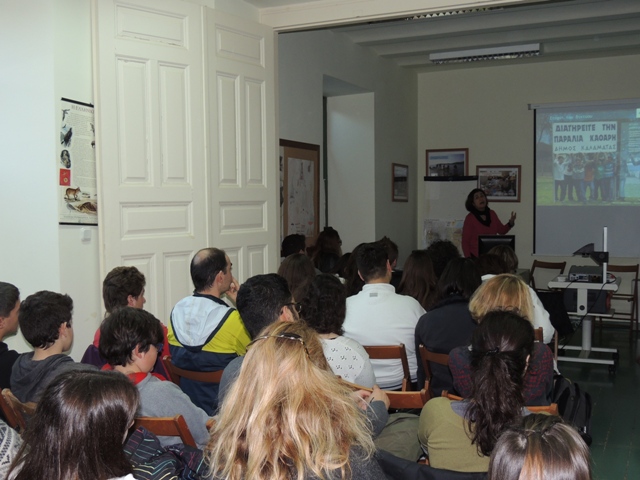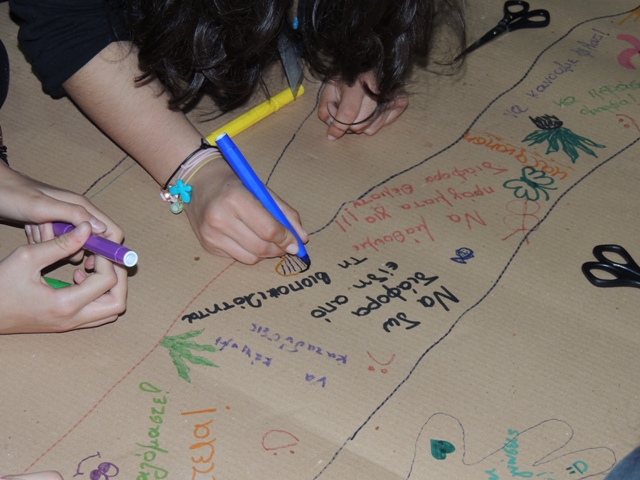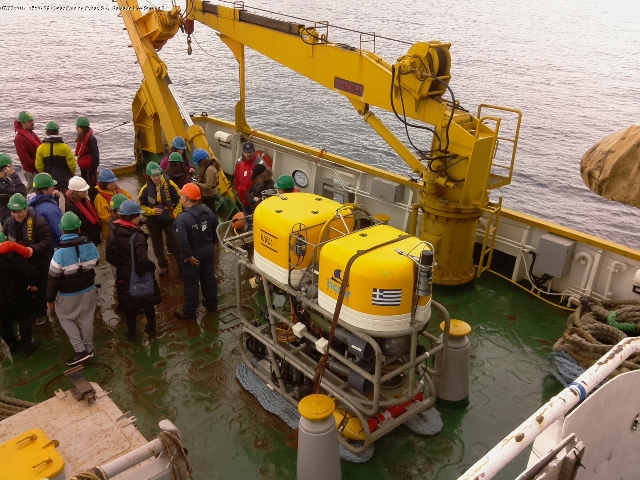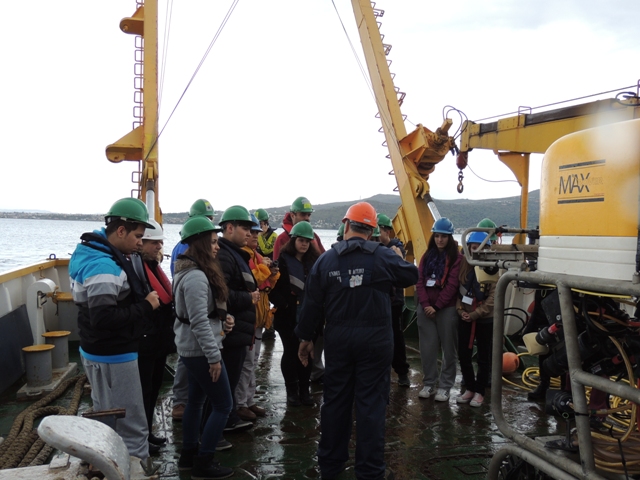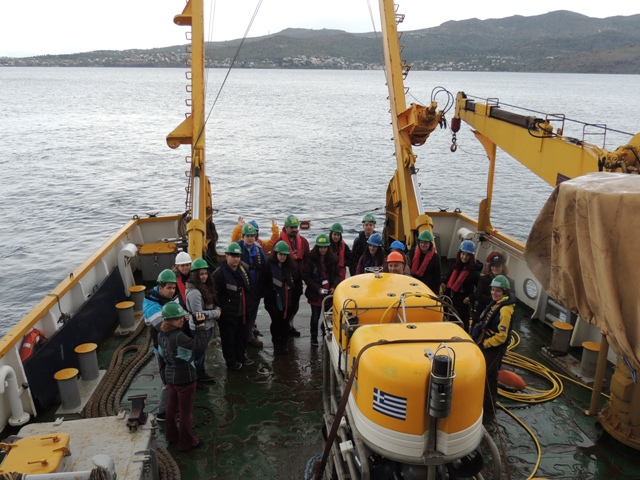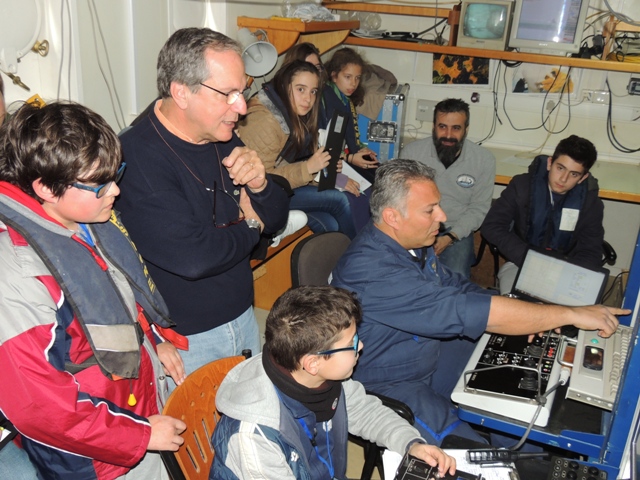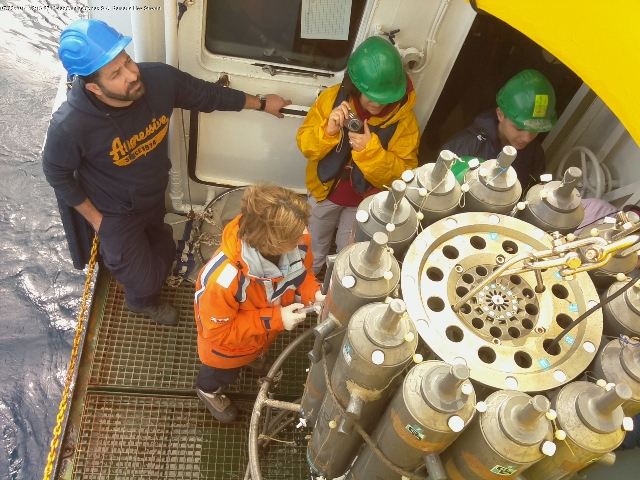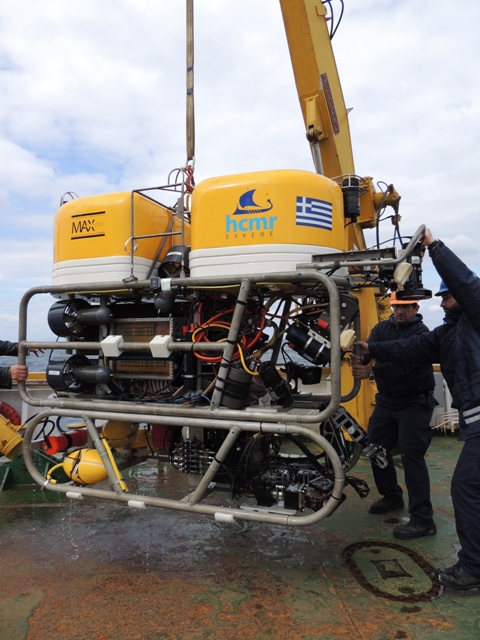Perseus@School
ANDROMEDA I (6-9 March 2014)
CRUISE DESCRIPTION
Twenty students from 10 Junior High and High Schools, 15 educators, 20 researchers and 22 crew members worked together onboard the research vessel AEGAEO, fully equipped like a laboratory with the latest state of the art instruments used currently in oceanographic research.
During the cruise, which took place in the Saronikos Gulf, off the coast of Athens, the students assumed specific "scientific roles" and will study the both pelagic and benthic ecosystems.
Like real scientists, they took part in the collection and storage of water and plankton samples, as well as fauna and sediment samples collected during the cruise, while they observed the biodiversity of the seabed with the use of a Remotely Operated Vehicle (ROV). They then processed the samples both onboard the laboratory on AEGAEO as well as the HCMR's laboratories in Athens, while they were simultaneously in contact with the environmental education teams of their respective schools via a Skype connection.
The "young oceanographers" attempted, under various environmental conditions, to answer the following questions:
• What is the bacterial, phytoplankton and zooplankton biomass at the selected sampling station of this cruise?
• Which plankton groups are favoured under different environmental conditions?
On the last day of the cruise, all 'researchers', including the students, drew conclusions via an interdisciplinary approach, and put forward their ideas and suggestions on how to best protect the Mediterranean.
The cruise continued onboard and in the lab....
• Press Release
• Educator's Guide - Supportive educational material
....some videos from the cruise....
Scientific Questions
4. Why are the vertical mixing and the thermocline so important in the distribution of chlorophyll and nutrients in the water column?
3. What is marine pollution caused by hydrocarbons?
2. What is the oxygen distribution in the water column? When do we see lack of oxygen (hypoxia-anoxia) and what are its consequences on the marine environment?
1. How do the physical characteristics of seawater (salinity and temperature) vary in coastal areas depending on depth and on the different seasons of the year?
Display of the Oceanographic Vessel
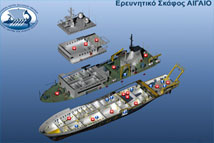
Do you want to visit a real oceanographic vessel? Click on the picture to see a 3D representation of HCMR's researach vessel and visit the deck and the labs of R/V AEGAEO!
DURING STUDENTS EXPEDITION
We had a live connection via a web camera and thus watched in real time the oceanographic research expedition from this address or by clicking on the video thumbnail image.
In this way, the youngsters could watch the other group of researchers who worked in the HCMR laboratories while their peers from school and their teachers and families from home were also able to watch them live!
First Day
The first day is quite important for the oceanographic mission. The students are anxious and curious when they come into the center that will accommodate them for the duration of the mission, which is the Environmental Education Centre of Lavrion and after they settle down, they are ready for their first update. The presentations from the students and the material that the scientists used to introduce students to the PERSEUS project and the Andromeda activities can be found here....
Second Day
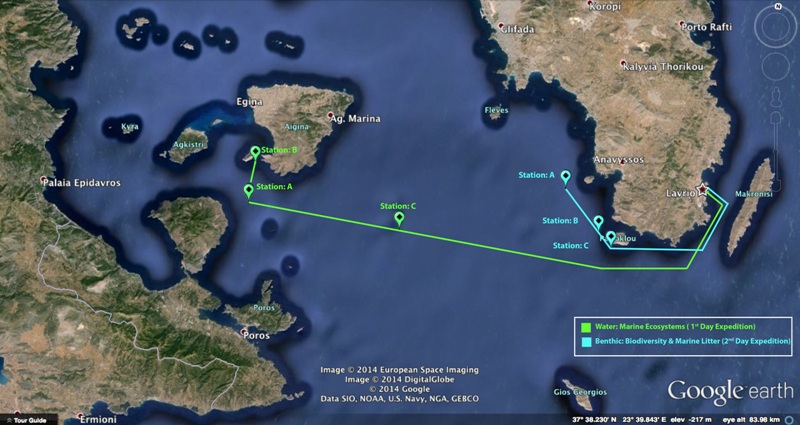 1st day on-board continued....
1st day on-board continued....
Upon arrival at the first sampling station, a complete analysis of the water column was carried out, east of the Methana peninsula. The collection of samples has already begun which will then be taken into the labs for further analysis. The children are getting more excited as the Underwater Activities Team is approaching to inform them on the deck. The second station was outside the village of Perdika, on Aegina island, where the small ROV was deployed and we observed the seabed and the plants and animals present, so that they can be compared to the ones observed by the other team the following day, whose main activity would involve ROV handling and sea bottom observations. Afterwards, a tour of the ship bridge was given by the captain. We ended the day with our third and final station, north of the island of Poros, where we experienced a small adventure: the sampler broke down, but thta's exactly why the scientists are here! Our work continued, while the group at the HCMR was updated about the activities of the Centre, visited the laboratories and got to see the 'Thetis' submersible in a guided tour.
1st day on-boardThe expedition begins with two groups of children who carefully follow the first instructions given. The first group (group A) board the oceanographic R/V AEGAEO and the first PERSEUS trip begins! The purpose of this educational activity is for the participating teachers and students to become familiar with the functioning of marine ecosystems and the consequences that natural and human pressures have upon them. During the journey data collection and water sampling took place in order to determine physical, chemical and biological oceanography parameters. The second team (group B) arrived at the HCMR their tour will begin. The two groups communicate through live web streaming cameras. Each group was assigned a research activity (water sampling, measurements of physical parameters, determination of dissolved oxygen and phosphate salts, bacteria - phytoplankton and zooplankton , measuring hydrocarbon pollution), alternating between Biology and Chemistry parameter analysis.
Third Day
Third day of ExpeditionThe next day is even more exciting because the team that went onboard the R/V Aegaeo describes their journey and their experience to the other group which remained at the HCMR. The children boarded the R/V Aegaeo and the Underwater Activities Team informed everyone about the day's activities and the deployment of the ROV (Remote Operated Vehicle).
Arrival at the first station, off the Anavyssos's coast, where the ROV takes its first dive for observation and recording of the litter on the seabed. The litter inventory is considered tentative and is in accordance with the instructions of the scientists. In the electronic laboratory, everyone can see all the information sent from the ROV, through screens displays connected to the ROV cameras, the sounder sonar and sub bottom profiler instruments.
At the second station, near the island of Patroklos, the ROV is submerged and a surprise awaits us. It is a shipwreck, a metal fishing vessel that sank 30 years ago! At this station the biodiversity is observed which is clearly greater with many small fish and many algae covering the ship ....
With even greater curiosity, now at the third station, also near the island of Patroklos, the seabed observation and recording of marine litter continues, with more experience this time! During this station another surprise awaits the young scientists. In pairs of two, the young scientists drove the ROV following the instructions given by the Underwater Activities Team! Driving the ROV went smoothly and each pupil was awarded a 'Rooky ROV pilot' diploma! Congratulations!


